We addressed our audience by giving them an opening sequence with farmilar forms to others and addressed the horror fans by using horror conventions. We attracted them by getting in touch with their feelings and filling the film with unique attributes.
The opening sequence conventions are mentioned on Question 1 but I will outline them here:
- Consistent credits with a main title at the end.
- Clear location and setting (establishing shots of the basement and good mis-en-scene).
- Introduction of characters (a minute of dialogue and interaction between them to get a feel for their relationship and personalities).
- Good continuity by use of shot/reverse shot and the 180 degree rule continued throughout the conversation scene. Also, the use of matched on actions such as the killer putting the victim to sleep with the cloth before pulling his arm away in the next shot as he turns to leave the victim sleeping (1.40 mins). This prevented distraction from the film because of lack of flow in the continued story.
- Use of enigma codes to get the audience to interact and fall into the film world.
The first thing we did to appeal to our audience was chose a popular genre with our core audience of 18-25's, and we thought horror was extremely popular, especially the 'Saw' and 'Hostel' films. Therefore we had to conform to their expectations by making our horror similar to that of the 'Saw' films.
My favourite aspect of the openings to 'Saw' was the variety in pace. It began very steadily, holding back lots of information and the actual appearance of the characters. Instead it focused on miscellaneous objects such as walls, pipes and bulbs, and the characters tied up were revealed bit by bit, with CU's of feet, eyes and mouth, before the shots moved further away from the character. It was 30-40 seconds before the actual character and location was revealed. We tried to achieve this affect in our film with opening credits appearing alongside random objects, helping establish the basement atmosphere, and a confusing montage of the victims face waking up to give a dazed effect. There was not an establishing LS until 33 seconds in, which helped lure the audience. Like 'Saw' the film did not pick up unnecessary pace and continued steadily through the dialogue. [The following compare 'Saw' on the left to 'Reservation' on the right, comparing first victim CU and then lightbulb shots].
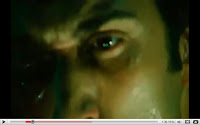
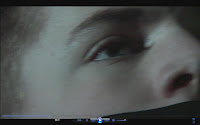


- When our killer begins to get angry and ends up shouting at his victim (1.27 mins) - he manages to compose himself to bring the film back down to slow pace again (helped by the rise and fall in the musics dynamics).
Other aspects we focused on to meet expectations of horror fans:
- Cinematic look with half-dim lighting in a pitch black room, added to by use of blue gel to create a blue tint (right) unique to our film (similar to use of neon green in 'Saw II' - left).
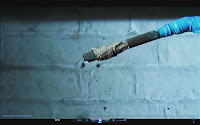
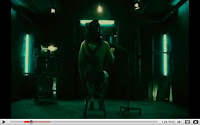
- A confusing montage of the victim waking up at the beginning (0.20-0.30 mins & below) unnerves the audience by disturbing the time period (similar to scene used in 'Hostel').
- Scrawly disorganised font on the credits and title (right) add to the confusion, being a bit like messy handwriting as if the person writing them is in pain. It is unsettling how the titles appear almost randomly throughout the sequence in different sizes, and how the title at the end fades in with each letter appearing at different times in no order at all. It created a mysterious code-cracking effect, as if you had to work hard to realise what the title said and that you may have to look deeper into the film to discover the answers (much like the titles in 'Cloverfield (Reeves, 2008)' (left - best picture I could find) are crackled such as on a fuzzy TV set, representing how the film is more meaningful than it looks and you have to search deep for clues [e.g. the last shot of New York which is set in the past before the whole story happened, a faint line can be seen falling into the sea and this is meant to be how the alien reached earth before the film started] because it is artistic.
- Low-key lighting (right) added to by the flickering lights. We filmed with 3 fairly dim studio lights to highlight shadows in all areas of the characters much like the characters in this particular scene in 'Sin City (Miller & Rodriquez, 2005)' (left) This highlights the expressions of the characters in a particular deep and meaningful scene such as our opening sequence - it is an important part of the story.
- Realistic atmosphere created by added on sounds (diegetic) such as lighting buzz (0.05-0.08 mins) and dripping water (0.15-0.18), giving our film a new dimension - a "spotlight" kind of effect where every little bit of action stood out and was detailed - bringing the audience into the world of the film (e.g. the amplified dripping water and ringing telephone in 'The Ring' (Verbinski, 2002)) [all added on sounds from http://www.soundsnap.com/].
- Use of moody music (non-diegetic) to create a tense atmosphere beyond the reality of the film [music called 'The Platform' from http://www.freeplaymusic.com/].


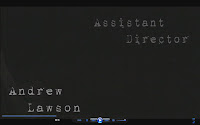

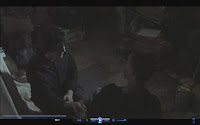
- An intriguing plot carrying a hotel-theme and a well-mannered killer. Enthusiasts would want to know why he is acting this way and what the hotel-theme represents. Our film has a carefully written script, giving the audience subtle hints and clues (e.g. "would you like a glass of water?" said by the killer in a hotel-host kind of way.
- The title helps promote this plot and stir interest. 'Reservation' refers to a hotel reservation. However, I believe it could have been far more effective if it had been called 'The Guests', which is much more to the point and possibly sinister if not easier to remember. Reservation is too long and has too many meanings, making it not mean much at all to the audience in terms of the plot.
- Plenty of enigma codes because of heldback information (this links to the point about the pace of the film), raising questions within the audience and making them want to watch more. The ending to our sequence poses such questions as to whose limbs the hand and foot were and how these victims got there (see 1.50 & 2.00 mins). There is loads of information still to find out (character details such as names are not known at all yet).
- We made our opening scene very intimate with the tight claustrophobic location of the basement (low ceilings and not much space) and the expressions of characters were highlighted by low-key lighting. A combination of good script-writing and excellent acting made the dialogue scene very intense. The audience would immediately feel sorry for our victim as he seems innocent (he is a lot smaller than the killer and is almost being bullied) and the humiliation and tease of this victim seem unnecessary. All the audience can see of the killer is evil as they do not know about his past and just think he is getting a "kick" out of torturing and killing people. Our scene plugs into the audiences emotional pleasures as they are on a characters side and may begin to care for the safety of this character. In scenes where the killer is particularly evil just provokes more of this responce to the film, with emotions such as sadness, anger, sympathy and desperation (we feel these emotions watching films such as 'Saw' as we capture the intense desperation of the characters in their situations due to the realims). The audience are helpless to do anything and may forget the character is fictional.
- Emotional pleasures can lead to visceral pleasures, which are the stimulated physical reactions of the audience to our film. Our opening sequence could provoke many, with sadness causing tears, wittyness causing laughter and anger causing people to tense up. Other than these emotions, the actual sequence itself is stop-starty and up and down a bit like a 'rollercoaster ride'. The pace quickens and slows with the music and the anticipation is high to go with the shocks that make people jump and the twists that make people admire the film in a physical way (i.e. shaking their head in disbelief or crying out). The most common physical reaction to emerge from watching our sequence is a sense of revulsion to what the killer is implying subtly and how he strokes the crow-bar. People cringe thinking about what might happen to the victim as you can faintly see the weapons lined up in the background. The audience are scared the film will become gory and they might often feel the pain (as you do watching 'Hostel' because it is horribly realistic). From our sequence, the gag being ripped off (0.45 mins) could cause someone to jump back or scream out in pain, and the thought of gore and death can cause a nauseous feeling.
- The enigma codes in our film provide the audience with something to solve so anyone can predict what might happen and try and link the important information together to find out what is going on (such as in 'Psycho', we try and guess who is commiting the murders). Solving something can give a sense of pleasure and not being able to know something can frustrate the audience until the end of the film when they find out.
- There is a counter-culture attraction stemming from our film as we release the audience from all rules and regulations. Our opening scene is private, away from authorities, and the killer has complete control. He can do whatever he wants and there are no limits (such as Michael Myers's unlimited power and freedom in 'Halloween'). Our audience get to feel a pleasure from the feeling they have broken rules by watching extreme situations such as our capturing scene.
- A sense of claustrophobia, being trapped or captured.
- Voyerism and the idea of being constantly watched or monitored.
- A sense of being alone in a situation in which you have to try and save yourself with your own thinking - nobody else knows where you are.
- Sense of darkness and night time and being stuck in a creepy-looking location.
- Being surrounded by strangers and bodies.
- Fear of the unknown, what is happening to the victim?
- Fear of the anger of someone you don't know and cannot reason with.
- Fear of unbelievable pain that you cannot defend.
- The fear of death and never being able to see loved ones again.
We applied all these audience factors to our sequence and every decision made that I discussed in this question was made for a reason. It is hard to sum it all up in one question so I tried explaining some thing in detail and others in less detail, but they were all meaningful to appealling to our audience. Whether they were successful or not was down to our audience feedback.
After having an audience screening in front of thirty 17-18's we were able to summarise their opinions and criticisms. It was successful feedback with 11 sample questionnaires (many who had a particular interest in horror) all stating that they enjoyed our sequence and thought it was attractive, so our attention to detail in image and style were helpful. Good points for the film were its clear narrative, depth in the killer's character, scariness of the killer's acting and the shock of the hand at the end. This was very pleasing with both dramatic parts being effective on the audience and making them react (everybody in the room jumped at the shock-ending). The holding back of the pace must have worked to amplify the jumpy moments. There was some constructive criticism; not everybody liked the lights flickering because regular intervals of darkness remained distracting (right). This is something we had thought about before but could not eradicate after shooting. People also had their reservations on the title, which I discussed earlier in this question. The last critical comments were mainly on our victims's acting when the gag was pulled off (0.45 mins) and that this could have seemed more painful and shocking (left). This was a hard shot to film as the gag kept coming off for certain reasons, so we understand how this moment seemed particularly flat at the time. I believe our groups attempts to appeal to this type of audience was very successful (most people stating their desire to continue watching). This was also evident in feedback I recieved elsewhere with my brother and cousin (both between 18-25 years old) getting a feel for the film and being more involved in possible improvements, whereas as 40 year olds like my mum were confused by the plot and dazzled by the lights - so did not get the modern horror genre so much.


























No comments:
Post a Comment